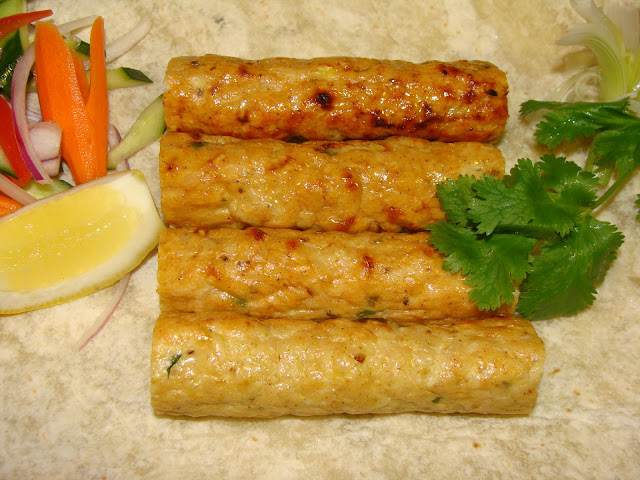Laal Maas is a traditional Rajasthani dish, made with goat/lamb and mostly accompanied with Bajra Ki Roti (Pearl millet flat bread). Laal Maas gets it's name from the huge quantity of dry red chillies used to prepare the dish. If you use the recommended amount of chillies, the dish can get very very hot. So the secret is to substitute half of the fiery-hot chillies with dry kashmiri chillies. Kashmiri chillies impart the bright red color with little heat.
Wednesday, May 29, 2013
Thursday, May 23, 2013
Chicken Seekh Kabab on Rumali Roti
This Seekh Kabab is made of ground chicken, mixed with spices and herbs and then press moulded on metal skewers, cooked over charcoal in tandoor. Rumali Roti is soft and thin like handkerchief. This bread is made from a mix of whole wheat flour and all purpose flour and is baked on an inverted skillet. Rumal means handkerchief and Rumali Roti means Handkerchief Bread.
Monday, May 20, 2013
Stuffed Bell Peppers
Twice baked potatoes stuffed in bell peppers.
Who doesn't love bell peppers right, especially the red, yellow and green ones stuffed with potatoes tempered with cumin seeds, fresh cilantro and baked. This dish is a meal in itself as it incorporates your protein, starch and veggies.You can also stuff these with variety of fillings like ground beef or ground chicken topped with cheese. Bell peppers are high in vitamin C but one large Red bell peppers has three times more vitamin C and nutrients then orange bell pepper.
Who doesn't love bell peppers right, especially the red, yellow and green ones stuffed with potatoes tempered with cumin seeds, fresh cilantro and baked. This dish is a meal in itself as it incorporates your protein, starch and veggies.You can also stuff these with variety of fillings like ground beef or ground chicken topped with cheese. Bell peppers are high in vitamin C but one large Red bell peppers has three times more vitamin C and nutrients then orange bell pepper.
Thursday, May 16, 2013
KADHAI GOSHT (LAMB)
Kadhai Lamb is a North-Indian lamb dish cooked in an abundance of tomatoes with the predominant flavors of fenugreek, coriander and cumin. This dish got it's name from the cooking utensil 'KADHAI' means wok, a typical Indian iron cooking utensil used in preparing it.. Most Indian prefer Mutton (goat meat) to Dumba (lamb meat) with a little fat on it ... this fat gives a very distinguished taste and great flavor to the dish.
Wednesday, May 8, 2013
Tangdi Kabab
Tangdi means leg. This chicken drumstick kabab is bar-be-cued with the bone in a charcoal tandoor which results in spice infused flavorful succulent kabab. If you don't have tandoor, you can cook this kabab in an oven too.
Monday, May 6, 2013
Murgh malai Kabab
I have made this magnificent, creamy, melt-in-the -mouth Kabab from the breasts of the chicken. It combines the joys of traditional spices and herbs with mild cheddar cheese.
TIPS: While bar-be-cuing baste the Kababs at least three times. It is the application of clarified butter or extra virgin olive oil which seals in the juices and makes the kababs succulent.
TIPS: While bar-be-cuing baste the Kababs at least three times. It is the application of clarified butter or extra virgin olive oil which seals in the juices and makes the kababs succulent.
Saturday, May 4, 2013
Kadhi Pakodi
A very simple dish, Kadhi-Pakodi originates from the northern state of Punjab- the land of milk and honey. Potato and onion dumplings simmered in a yogurt and chic pea based stew tempered with fenugreek seeds, mustard seeds and cumin seeds. This is usually eaten for lunch with plain rice or pan breads like chapati
Friday, May 3, 2013
Shrimps in Hot Garlic Sauce
Indo-Chinese Cuisine came into existence when the Chinese community settled in India (Calcutta) between 1820 - 1837. Chinese food in India became very popular as the taste was modified to satisfy the Indian palate. Today Modern Indian-Chinese is one of the favorite cuisines after Indian food in India. Chicken Manchurian and Hakka cuisine being the most sought after. Indian Chinese meal includes chicken, shrimp or vegetable variants of Hakka or Szechwan noodles popularly referred to as Chow Mein and Szechwan Fried Rice. American Chop Suey and Sweet and Sour dishes can be found at many restaurants.
Thursday, May 2, 2013
Nalli Nihari (Lamb Shank)
Nalli Nihari ( Lamb Shank) originated in Jama Masjid and near by Daryaganj area of Old Delhi city of India during Mughal Empire in the late 18th century. Later on this dish was perfected in the Royal Kitchens of Awadh. Nihari is cooked overnight which results in extremely tender meat. This Nihari recipe calls for 6-8 hours of cooking time. It is garnished with fresh cilantro, juliennes of ginger and a lemon wedge. Traditionally the dish is eaten in the early hours of the morning. It is eaten for lunch and dinner too. Best enjoyed during winter and best eaten with Naan.
Subscribe to:
Posts (Atom)








